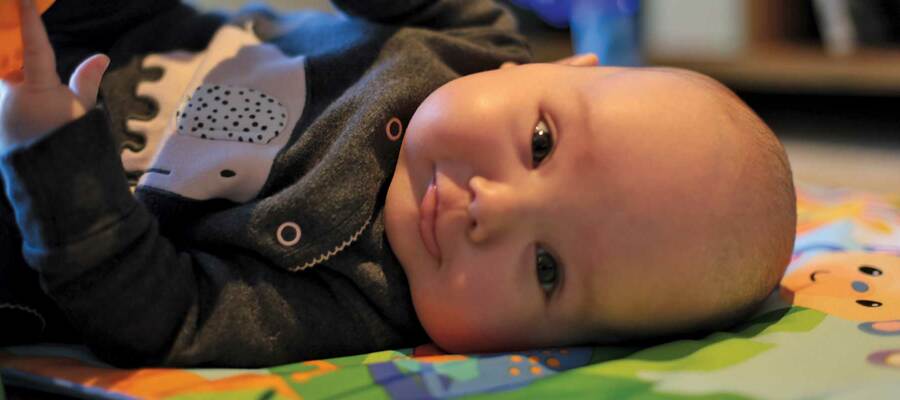
How to learn like a baby
Question: what is the easiest way to roll from your back to your side? Give it a go. It's fun! Try it out on your bed (or anywhere if your back is happy enough).
You will probably find that the answer is to raise your legs until they are straight up in the air, and then shift your weight so that gravity naturally brings you down onto your side.
When my baby daughter was born, like all babies, she was unable to do this. However, she learnt. How did she do this, and what lessons can we take from the experience to apply to our learning?
How babies learn to roll
Babies face two problems when they are first born: they are not strong enough to roll, and they do not know how to do it. The first is quickly solved as they grow at a tremendous rate.
The second point requires them to learn how to roll. There is no magic trick here. They do not watch YouTube videos. They do not get an instructor. They do not take classes. They use one technique alone: simple trial and error. They repeatedly try things over and over again.
The learning happens in stages. First, she learnt to pull her legs up in the air. She spent weeks doing this. Hundreds of times per day for week after week.
After this, she began practising shifting her weight so that she would come down on one side. Once again, mere repetition was the order of the day. Over and over again, for hours, she would try and shift her weight to get to her side.
Where adults go wrong
We face one major obstacle when we try to learn anything as adults. There is one problem, above all others, that prevent us from mastering a new skill: we do not stick at it.
Time after time we will pick something new up, but then give up before we have learnt it. We do not immediately get the results we hoped we would magically achieve, and so we stop putting in the effort and abandon our quest.
This is a shame because the key to learning is sustained practice. You can learn almost anything if you put in enough work. I only started learning guitar at the age of 27. It was tough, but vigilance in my practice schedule eventually won the day. Now I play in a band named The Assembly Line.
Was it easy? No! I had to practice for hours per day for months. I was a slow learner. But was it worth it? Hell yes! Playing an instrument is awesome.
Why we fail to stick at things
Let's face it, there is one major reason why we fail to follow through on things: we are worried that we will fail. It is anxiety that gets in the way.
We look at the path before us and think "what if I put all of this time and effort in and I get no results? What if I am simply not good enough to learn this?"
We quit before we have had time to find out because we do not want to risk the possibility of damaging our self-esteem when we do put the work in and still fail.
At this point, our memory begins to trick us. It forgets all the skills you have learnt and reminds you of all the things you failed at. It forgets how excited you were to start learning and tells you that you will not enjoy the skill after you have mastered it.
We have the advantage
It is easier for adults to learn than it is for babies. As a baby, you have none of the resources that we do. You have to try things, and then practice them over and over again in the hope that they will work.
As adults, our learning can be much more focused. We have experience, motivation, communication and reasoning on our side1. We can set up a practice schedule, learn from books, audio and video, take classes and hire private tutors. We can set ourselves challenges, offer ourselves rewards and fully understand the long-term benefits of our learning.
We never learn the ability to learn new skills. Our brains may not be quite as quick as we age, but our increased skills and experience can compensate for this2.
What can we learning from this
Despite all the advantages we have, so often we fail to achieve our goals. In contrast, babies, who have none of these tools available, inevitably learn to roll into their side. And then crawl. And then walk. No matter how many times they fall at first.
The problem is mindset: we let our anxiety tell us that we cannot learn, and therefore that there is no point trying.
Conclusion
Babies learn by simple repetition. They just try things over and over again for months until they work.
As adults, we can learn much faster than this. We can use all of the tools we have available to create deliberate, structured practice.
However, this only works if we put ourselves in the mindset that we can learn. We need to enter learning with knowledge that it is going to be hard, but with the persistence of a baby, we can learn whatever we want.
Metadata
Published 24 April 2017. Written by Chris Worfolk.
References
-
Fredrik D. Pociask, Rosanne DiZarro-Miller, and Joseph M. Pellerito Jr. Learning as an Adult and Cognitive Factors in Learning. p21. http://samples.jbpub.com/9780763757687/57687_CH02_DiZazzo.pdf ↩︎
-
Mo Costandi. Am I too old to learn a new language? The Guardian. 13 September 2014. https://www.theguardian.com/education/2014/sep/13/am-i-too-old-to-learn-a-language ↩︎